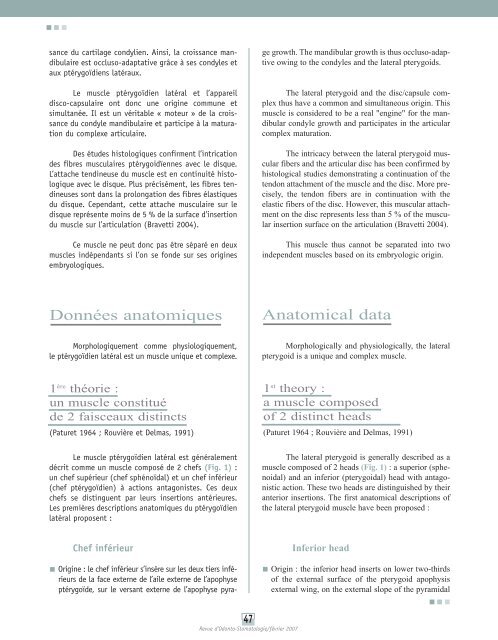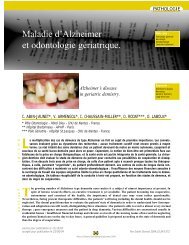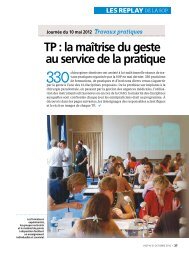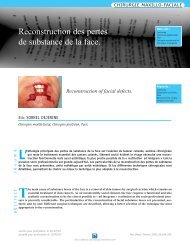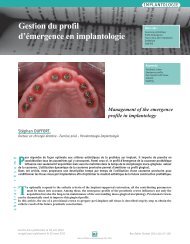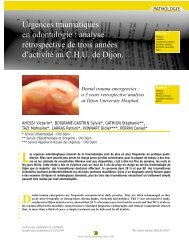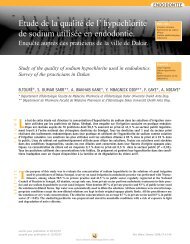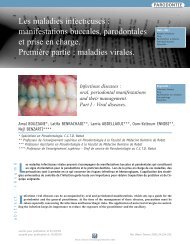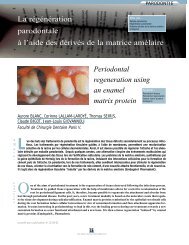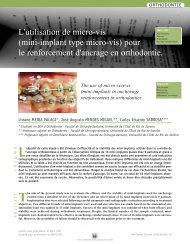Lateral pterygoid muscle - SOP
Lateral pterygoid muscle - SOP
Lateral pterygoid muscle - SOP
You also want an ePaper? Increase the reach of your titles
YUMPU automatically turns print PDFs into web optimized ePapers that Google loves.
sance du cartilage condylien. Ainsi, la croissance mandibulaireest occluso-adaptative grâce à ses condyles etaux ptérygoïdiens latéraux.Le <strong>muscle</strong> ptérygoïdien latéral et l’appareildisco-capsulaire ont donc une origine commune etsimultanée. Il est un véritable « moteur » de la croissancedu condyle mandibulaire et participe à la maturationdu complexe articulaire.Des études histologiques confirment l’intricationdes fibres musculaires ptérygoidïennes avec le disque.L’attache tendineuse du <strong>muscle</strong> est en continuité histologiqueavec le disque. Plus précisément, les fibres tendineusessont dans la prolongation des fibres élastiquesdu disque. Cependant, cette attache musculaire sur ledisque représente moins de 5 % de la surface d’insertiondu <strong>muscle</strong> sur l’articulation (Bravetti 2004).Ce <strong>muscle</strong> ne peut donc pas être séparé en deux<strong>muscle</strong>s indépendants si l’on se fonde sur ses originesembryologiques.■ Origine : le chef inférieur s’insère sur les deux tiers inférieursde la face externe de l’aile externe de l’apophyseptérygoïde, sur le versant externe de l’apophyse pyragegrowth. The mandibular growth is thus occluso-adaptiveowing to the condyles and the lateral <strong>pterygoid</strong>s.The lateral <strong>pterygoid</strong> and the disc/capsule complexthus have a common and simultaneous origin. This<strong>muscle</strong> is considered to be a real "engine" for the mandibularcondyle growth and participates in the articularcomplex maturation.The intricacy between the lateral <strong>pterygoid</strong> muscularfibers and the articular disc has been confirmed byhistological studies demonstrating a continuation of thetendon attachment of the <strong>muscle</strong> and the disc. More precisely,the tendon fibers are in continuation with theelastic fibers of the disc. However, this muscular attachmenton the disc represents less than 5 % of the muscularinsertion surface on the articulation (Bravetti 2004).This <strong>muscle</strong> thus cannot be separated into twoindependent <strong>muscle</strong>s based on its embryologic origin.Données anatomiquesAnatomical dataMorphologiquement comme physiologiquement,le ptérygoïdien latéral est un <strong>muscle</strong> unique et complexe.Morphologically and physiologically, the lateral<strong>pterygoid</strong> is a unique and complex <strong>muscle</strong>.1 ère théorie :un <strong>muscle</strong> constituéde 2 faisceaux distincts(Paturet 1964 ; Rouvière et Delmas, 1991)Le <strong>muscle</strong> ptérygoïdien latéral est généralementdécrit comme un <strong>muscle</strong> composé de 2 chefs (Fig. 1) :un chef supérieur (chef sphénoïdal) et un chef inférieur(chef ptérygoïdien) à actions antagonistes. Ces deuxchefs se distinguent par leurs insertions antérieures.Les premières descriptions anatomiques du ptérygoïdienlatéral proposent :1 st theory :a <strong>muscle</strong> composedof 2 distinct heads(Paturet 1964 ; Rouvière and Delmas, 1991)The lateral <strong>pterygoid</strong> is generally described as a<strong>muscle</strong> composed of 2 heads (Fig. 1) : a superior (sphenoidal)and an inferior (<strong>pterygoid</strong>al) head with antagonisticaction. These two heads are distinguished by theiranterior insertions. The first anatomical descriptions ofthe lateral <strong>pterygoid</strong> <strong>muscle</strong> have been proposed :Chef inférieurInferior head■ Origin : the inferior head inserts on lower two-thirdsof the external surface of the <strong>pterygoid</strong> apophysisexternal wing, on the external slope of the pyramidal47Revue d’Odonto-Stomatologie/février 2007


